|
|
|
Sort Order |
|
|
|
Items / Page
|
|
|
|
|
|
|
| Srl | Item |
| 1 |
ID:
111360


|
|
|
|
|
| Publication |
2012.
|
| Summary/Abstract |
Wind farms are becoming increasingly popular in Ireland in an effort to increase the production of green energy within the state. As with any infrastructural development, wind farms must consider potential environmental impacts prior to construction. One particular issue that must be examined is the emission of noise from the development. In Ireland wind farm developments must adhere to planning conditions that usually outline permissible noise levels for both the construction and operational phases of the development. The critical wind speed is often cited as the wind speed at which these limits apply. This paper examines how the critical wind speed is determined and investigates its relationship with background noise levels and turbine choice. The study consisted of ten one-week monitoring periods during which meteorological conditions and background noise levels were simultaneously recorded. It was found that the critical wind speed is non-transferable, i.e. it depends on both the turbine choice and background noise environment and is specific to that particular turbine/site combination. Furthermore the critical wind speed during the night-time is often different to the overall critical wind speed suggesting that future noise studies should consider a range of critical wind speeds, particularly for night-time noise assessments.
|
|
|
|
|
|
|
|
|
|
|
|
|
|
|
|
| 2 |
ID:
150752


|
|
|
|
|
| Summary/Abstract |
The considerable amount of required infrastructure and renewable energy investments expected in the forthcoming years also implies an increasingly relevant contribution of private and institutional investors. In this context, especially regulatory and policy risks have been shown to play a major role for investors when evaluating investments in renewable energy and should thus also be taken into account in risk assessment and when deriving risk-return profiles. In this paper, we provide a stochastic model framework to quantify policy risks associated with renewable energy investments (e.g. a retrospective reduction of a feed-in tariff), thereby also taking into account energy price risk, resource risk, and inflation risk. The model is illustrated by means of simulations and scenario analyses, and it makes use of expert estimates and fuzzy set theory for quantifying policy risks. Our numerical results for a portfolio of onshore wind farms in Germany and France show that policy risk can strongly impact risk-return profiles, and that cross-country diversification effects can considerably decrease the overall risk for investors.
|
|
|
|
|
|
|
|
|
|
|
|
|
|
|
|
| 3 |
ID:
149879
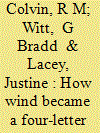

|
|
|
|
|
| Summary/Abstract |
Wind is recognised as a key source of renewable energy. Despite broad public support for the sector, wind energy proposals have routinely triggered social conflict and localised opposition. To promote social acceptance and avoid conflict, the wind energy sector undertakes community engagement. This paper interrogates the community engagement undertaken in King Island (Tasmania, Australia) for a large scale wind energy development proposal which did not proceed to implementation due to external economic factors. Despite the proponent's adoption of what was described as a ‘best practice’ community engagement strategy, the proposal caused significant social conflict for the community. In-depth interviews (n=30) were conducted with members of the King Island community and were qualitatively analysed through the social identity lens. Five key drivers of the local conflict were identified: problematic pre-feasibility engagement; the lack of a third-party facilitator of the community consultative committee; holding a vote which polarised the community; the lack of a clear place in the engagement process for local opposition, and; the significance of local context. These findings are instructive for improving community engagement practice for wind energy and other energy generation and land use change sectors.
|
|
|
|
|
|
|
|
|
|
|
|
|
|
|
|
| 4 |
ID:
092771
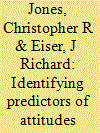

|
|
|
|
|
| Publication |
2009.
|
| Summary/Abstract |
The threats posed by climate change are placing governments under increasing pressure to meet electricity demand from low-carbon sources. In many countries, including the UK, legislation is in place to ensure the continued expansion of renewable energy capacity. Onshore wind turbines are expected to play a key role in achieving these aims. However, despite high levels of public support for onshore wind development in principle, specific projects often experience local opposition. Traditionally this difference in general and specific attitudes has been attributed to NIMBYism (not in my back yard), but evidence is increasingly calling this assumption into question. This study used multiple regression analysis to identify what factors might predict attitudes towards mooted wind development in Sheffield, England. We report on the attitudes of two groups; one group (target) living close to four sites earmarked for development and an unaffected comparison group (comparison). We found little evidence of NIMBYism amongst members of the target group; instead, differences between general and specific attitudes appeared attributable to uncertainty regarding the proposals. The results are discussed with respect to literature highlighting the importance of early, continued and responsive community involvement in combating local opposition and facilitating the deployment of onshore wind turbines.
|
|
|
|
|
|
|
|
|
|
|
|
|
|
|
|
| 5 |
ID:
176672
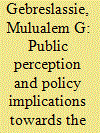

|
|
|
|
|
| Summary/Abstract |
As part of the global effort in the development and deployment of renewable energy, Ethiopia is aggressively working to increase the share of those energy resources into the energy mix. Ethiopia is known for the use of hydropower generation systems but recently the country is introducing wind energy technologies and developed wind farms that started power generation in 2011. However, the public perception towards this new entrant of power generation system is not well understood. This paper therefore explores the perception of the public living within the wind farms. This is achieved through structured survey and conducting household level discussions with the community. The results showed that generally the public is supportive of such development but critical issues have been raised such as lack of prior consultation with the community by the developers, fairness of land compensation and generally lack of inclusive benefit packages from the wind farm development for the community. With the country planning for new wind farm development, it is crucial to devise comprehensive solutions and consider the recommended policy directions in this paper in order to develop public confidence and ownership for sustainability of the developed power generation systems.
|
|
|
|
|
|
|
|
|
|
|
|
|
|
|
|
| 6 |
ID:
090042
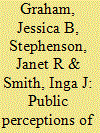

|
|
|
|
|
| Publication |
2009.
|
| Summary/Abstract |
Although the public generally hold positive attitudes towards wind energy, proposals for the construction of new wind farms are often met with strong resistance. In New Zealand, where the government has recently introduced ambitious policy targets for renewable energy generation, negative perceptions of wind farms are increasingly evident and have the potential to prevent the achievement of these targets. This research sets out to examine what influences social resistance to wind farms in New Zealand. Drawing from public submissions on three wind farm proposals, a framework developed by Devine-Wright [Devine-Wright, P., 2005a. Beyond NIMBYism: towards an integrated Framework for Understanding Public Perceptions of Wind Energy. Wind Energy 8, 125-139.] was used as the basis for identification of factors affecting public perceptions of wind farms. The research found firstly that there was no apparent relationship between the proximity of submitters to a proposed wind farm and their likelihood of having a negative perception of the proposal. A wide range of factors written in submissions appeared to have affected the submitter's decision to support or oppose the wind farm proposal. Some of these were consistent with Devine-Wright's findings, but ten further factors were added to the framework to adequately cover the aspects raised in submissions. The findings have implications for the achievement of New Zealand's energy policy
|
|
|
|
|
|
|
|
|
|
|
|
|
|
|
|
| 7 |
ID:
111446


|
|
|
|
|
| Publication |
2012.
|
| Summary/Abstract |
A Response Surface-Based Wind Farm Cost (RS-WFC) model is developed for the engineering planning of wind farms. The RS-WFC model is developed using Extended Radial Basis Functions (E-RBF) for onshore wind farms in the U.S. This model is then used to explore the influences of different design and economic parameters, including number of turbines, rotor diameter and labor cost, on the cost of a wind farm. The RS-WFC model is composed of three components that estimate the effects of engineering and economic factors on (i) the installation cost, (ii) the annual Operation and Maintenance (O&M) cost, and (iii) the total annual cost of a wind farm. The accuracy of the cost model is favorably established through comparison with pertinent commercial data. The final RS-WFC model provided interesting insights into cost variation with respect to critical engineering and economic parameters. In addition, a newly developed analytical wind farm engineering model is used to determine the power generated by the farm, and the subsequent Cost of Energy (COE). This COE is optimized for a unidirectional uniform "incoming wind speed" scenario using Particle Swarm Optimization (PSO). We found that the COE could be appreciably minimized through layout optimization, thereby yielding significant cost savings.
|
|
|
|
|
|
|
|
|
|
|
|
|
|
|
|
| 8 |
ID:
096151
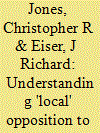

|
|
|
|
|
| Publication |
2010.
|
| Summary/Abstract |
In recognition of the environmental and economic threats posed by climate change; decisive steps are now being taken to stabilise greenhouse gas emissions. One sector receiving particular attention within the UK is that of electricity generation. As such, the government has introduced ambitious targets for increasing renewable generating capacity within the country. Wind turbines are expected to play a significant role in meeting these targets; however, despite high levels of support for the technology in principle, specific projects are often delayed or rejected on account of local opposition. This study aimed to establish how attitudes towards development might vary with respect to increasing distance from the identified sites. Participants were required to register their opinion towards development at a number of on- and off-shore locations in the UK. The results indicated that participants were most favourable to offshore development and least favourable to development at the identified sites. Attitudes to onshore development indicated that so long as a proposed location was anticipated to be 'out of sight' it was considered in relatively general terms. The results are discussed with reference to site visibility and landscape concerns and clearly support calls for a shift towards community-focussed development strategies.
|
|
|
|
|
|
|
|
|
|
|
|
|
|
|
|
| 9 |
ID:
107629


|
|
|
|
|
| Publication |
2011.
|
| Summary/Abstract |
The level of 'wind-prospecting' presently occurring in the UK is increasing the likelihood that new wind-power developments will conflict with other existing and/or proposed schemes. This study reports multiple-regression analyses performed on survey data obtained in a region of the UK (i.e. Humberhead Levels, near Doncaster) simultaneously subject to nine wind-farm proposals (September 2008). The aim of the analysis was to identify which survey-items were predictors of respondents' estimates of the number of wind turbines they believed the region could reasonably support (i.e. capacity estimates). The results revealed that the majority of respondents would endorse some local development; however, there was substantial variability in the upper level that was considered acceptable. Prominent predictors included general attitude, perceived knowledge of wind power, community attachment, environmental values, visual attractiveness of wind turbines, and issues relating to perceived fairness and equity. The results have implications for Cumulative Effects Assessment (CEA) - and in particular the assessment of Cumulative Landscape and Visual Impacts (CLVI) - and support calls for greater community involvement in decisions regarding proposed schemes.
|
|
|
|
|
|
|
|
|
|
|
|
|
|
|
|
| 10 |
ID:
168657


|
|
|
|
|
| Summary/Abstract |
The willingness to accept the construction of wind farms on private properties is investigated using a latent class model approach. This type of research is required in view of the frequent conflicts between landowners and system operators, who often pay little in easement compensation.
|
|
|
|
|
|
|
|
|
|
|
|
|
|
|
|
|
|
|
|
|